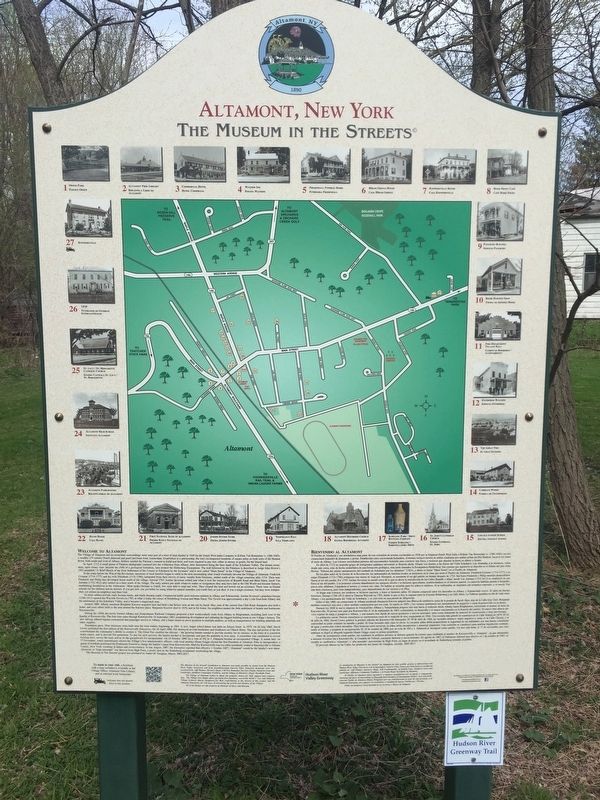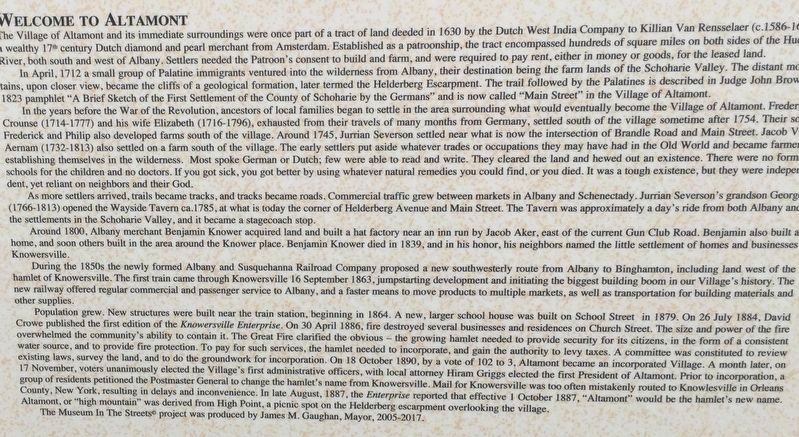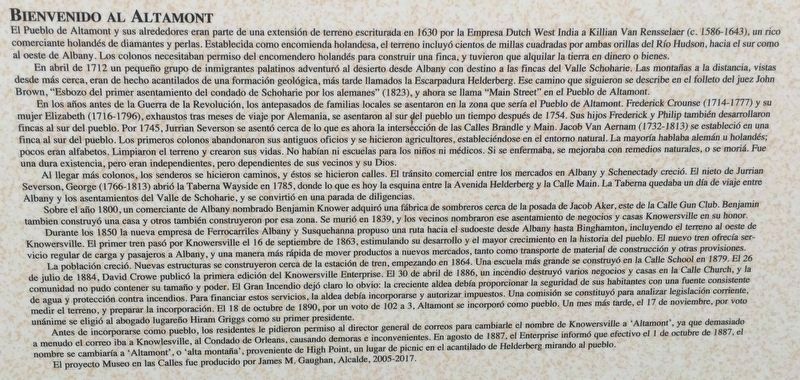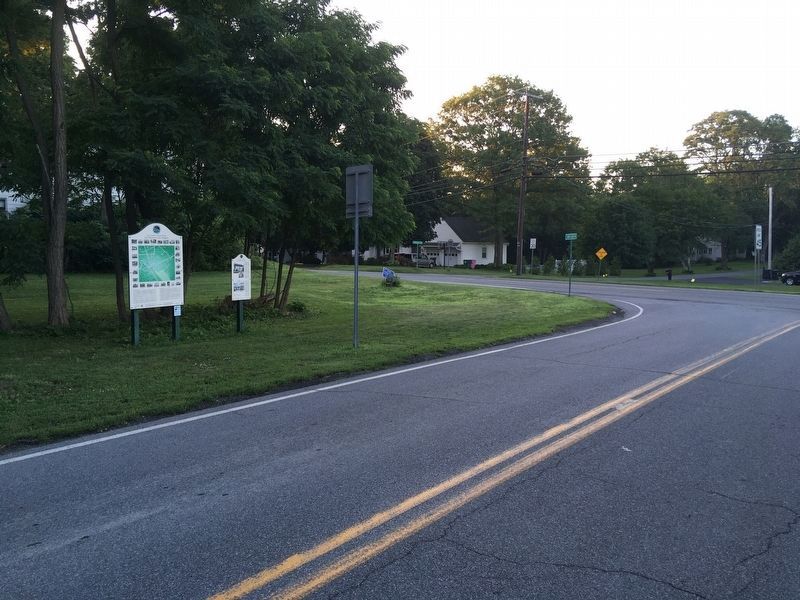Altamont in Albany County, New York — The American Northeast (Mid-Atlantic)
Altamont, New York
The Museum in the Streets
Welcome to Altamont
The Village of Altamont and its immediate surroundings were once part of a tract of land deeded in 1630 by the Dutch West India Company to Killian Van Rensselaer (c. 1586-1643),a wealthy 17th century Dutch diamond and pearl merchant from Amsterdam. Established as a patroonship, the tract encompassed hundreds of square miles on both sides of the Hudson River, both south and west of Albany. Settlers needed the Patroon's consent to build and farm, and were required to pay rent, either in money or goods, for the leased land.
In April, 1712 a small group of Palatine immigrants ventured into the wilderness from Albany, their destination being the farm lands of the Schoharie Valley. The distant mountains, upon closer view, became the cliffs of a geological formation, later termed the Helderberg Escarpment. The trail followed by the Palatines is described in Judge John Brown's 1823 pamphlet "A Brief Sketch of the First Settlement of the County of Schoharie by the Germans” and is now called "Main Street” in the Village of Altamont.
In the years before the War of the Revolution, ancestors of local families began to settle in the area surrounding what would eventually become the Village of Altamont. Frederick Crounse (1714-1777) and his wife Elizabeth (1716-1796), exhausted from their travels of many months from Germany, settled south of the village sometime after 1754. Their sons Frederick and Philip also developed farms south of the village. Around 1745, Jurrian Severson settled near what is now the intersection of Brandle Road and Main Street. Jacob Van Aernam (1732-1813) also settled on a farm south of the village. The early settlers put aside whatever trades or occupations they may have had in the Old World and became farmers, establishing themselves in the wilderness. Most spoke German or Dutch; few were able to read and write. They cleared the land and hewed out an existence. There were no formal schools for the children and no doctors. If you got sick, you got better by using whatever natural remedies you could find, or you died. It was a tough existence, but they were independent, yet reliant on neighbors and their God.
As more settlers arrived, trails became tracks, and tracks became roads. Commercial traffic grew between markets in Albany and Schenectady. Jurrian Severson's grandson George (1766-1813) opened the Wayside Tavern ca.1785, at what is today the corner of Helderberg Avenue and Main Street. The Tavern was approximately a day's ride from both Albany and the settlements in the Schoharie Valley, and it became a stagecoach stop.
Around 1800, Albany merchant Benjamin Knower acquired land and built a hat factory near an inn run by Jacob Aker, east of the current Gun Club Road. Benjamin also built a home, and soon others built in the area around the Knower place. Benjamin Knower died in 1839, and in his honor, his neighbors named the little settlement of homes and businesses Knowersville.
During the 1850s the newly formed Albany and Susquehanna Railroad Company proposed a new southwesterly route from Albany to Binghamton, including land west of the hamlet of Knowersville. The first train came through Knowersville 16 September 1863, jumpstarting development and initiating the biggest building boom in our Village's history. The new railway offered regular commercial and passenger service to Albany, and a faster means to move products to multiple markets, as well as transportation for building materials and other supplies.
Population grew. New structures were built near the train station, beginning in 1864. A new, larger school house was built on School Street in 1879. On 26 July 1884, David Crowe published the first edition of the Knowersville Enterprise. On 30 April 1886, fire destroyed several businesses and residences on Church Street. The size and power of the fire overwhelmed the community's ability to contain it. The Great Fire clarified the obvious - the growing hamlet needed to provide security for its citizens, in the form of a consistent water source, and to provide fire protection. To pay for such services, the hamlet needed to incorporate, and gain the authority to levy taxes. A committee was constituted to review existing laws, survey the land, and to do the groundwork for incorporation. On 18 October 1890, by a vote of 102 to 3, Altamont became an incorporated Village. A month later, on 17 November, voters unanimously elected the administrative office village's first administrative officers, with local attorney Hiram Griggs elected the first President of Altamont. Prior to incorporation, a group of residents petitioned the Postmaster General to change the hamlet's name from Knowersville. Mail for Knowersville was too often mistakenly routed to Knowlesville in Orleans County, New York, resulting in delays and inconvenience. In late August, 1887, the Enterprise reported that effective 1 October 1887, "Altamont” would be the hamlet's new name. Altamount, or"high mountain" was derived from High Point, a picnic spot on the Helderberg escarpment overlooking the village.
The Museum In The Streets® project was produced by James M. Gaughan, Mayor, 2005-2017
El Pueblo de Altamont y sus alrededores eran parte de una extensión de terreno escriturada en 1630 por la Empresa Dutch West India a Killian Van Rensselaer (c. 1586-1643), un rico comerciante holandés de diamantes y perlas. Establecida como encomienda holandesa, el terreno incluyó cientos de millas cuadradas por ambas orillas del Río Hudson, hacia el sur como al oeste de Albany. Los colonos necesitaban permiso del encomendero holandés para construir una finca, y tuvieron que alquilar la tierra en dinero o bienes.
En abril de 1712 un pequeño grupo de inmigrantes palatinos adventuró al desierto desde Albany con destino a las fincas del Valle Schoharie. Las montañas a la distancia, vistas desde más cerca, eran de hecho acantilados de una formación geológica, más tarde llamados la Escarpadura Helderberg. Ese camino que siguieron se describe en el folleto del juez John Brown, "Esbozo del primer asentamiento del condado de Schoharie por los alemanes” (1823), y ahora se llama "Main Street” en el Pueblo de Altamont.
En los años antes de la Guerra de la Revolución, los antepasados de familias locales se asentaron en la zona que sería el Pueblo de Altamont. Frederick Crounse (1714-1777) y su mujer Elizabeth (1716-1796), exhaustos tras meses de viaje por Alemania, se asentaron al sur del pueblo un tiempo después de 1754. Sus hijos Frederick y Philip también desarrollaron fincas al sur del pueblo. Por 1745, Jurrian Severson se asentó cerca de lo que es ahora la intersección de las Calles Brandle y Main. Jacob Van Aernam (1732-1813) se estableció en una finca al sur del pueblo. Los primeros colonos abandonaron sus antiguos oficios y se hicieron agricultores, estableciéndose en el entorno natural. La mayoría hablaba alemán u holandés os eran alfabetos. Limpiaron el terreno y crearon sus vidas. No habían ni escuelas para los niños ni médicos. Si se enfermaba, se mejoraba con remedios naturales, o se moriá. Fue una dura existencia, pero eran independientes, pero dependientes de sus vecinos y su Dios.
Al llegar más colonos, los senderos se hicieron caminos, y éstos se hicieron calles. El tránsito comercial entre los mercados en Albany y Schenectady creció. El nieto de Jurrian Severson, George (1766-1813) abrió la Taberna Wayside en 1785, donde lo que es hoy la esquina entre la Avenida Helderberg y la Calle Main. La Taberna quedaba un día de viaje entre Albany y los asentamientos del Valle de Schoharie, y se convirtió en una parada de diligencias.
Sobre el año 1800, un comerciante de Albany nombrado Benjamin Knower adquiró una fábrica de sombreros cerca de la posada de Jacob Aker, este de la Calle Gun Club. Benjamin tambien construyó una casa y otros también construyeron por esa zona. Se murió en 1839, y los vecinos nombraron ese asentamiento de negocios y casas Knowersville en su honor.
Durante los 1850 la nueva empresa de Ferrocarriles Albany y Susquehanna propuso una ruta hacia el sudoeste desde Albany hasta Binghamton, incluyendo el terreno al oeste de Knowersville. El primer tren pasó por Knowersville el 16 de septiembre de 1863, estimulando su desarrollo y el mayor crecimiento en la historia del pueblo. El nuevo tren ofrecía servicio regular de carga y pasajeros a Albany, y una manera más rápida de mover productos a nuevos mercados, tanto como transporte de material de construcción y otras provisiones,
La población creció. Nuevas estructuras se construyeron cerca de la estación de tren, empezando en 1864. Una escuela más grande se construyó en la Calle School en 1879. El 26 e julio de 1884, David Crowe publicó la primera edición del Knowersville Enterprise. El 30 de abril de 1886, un incendio destruyó varios negocios y casas en la Calle Church, y la comunidad no pudo contener su tamaño y poder. El Gran Incendio dejó claro lo obvio: la creciente aldea debía proporcionar la seguridad de sus habitantes con una fuente consistente de agua y protección contra incendios. Para financiar estos servicios, la aldea debía incorporarse y autorizar impuestos. Una comisión se constituyó para analizar legislación corriente medir el terreno, y preparar la incorporación. El 18 de octubre de 1890, por un voto de 102 a 3, Altamont se incorporó como pueblo. Un mes más tarde, el 17 de noviembre, por voto unánime se eligió al abogado lugareño Hiram Griggs como su primer presidente
Antes de incorporarse como pueblo, los residentes le pidieron permiso al director general de correos para cambiaarle el nombre de Knowersville a ''Altamont'', ya que demasiado a menudo el correo iba a Knowlesville, al Condado de Orleans, causando demoras e inconvenientes. En agosto de 1887, el Enterprise informó que efectivo el 1 de octubre de 1887, el nombre se cambiaría a 'Altamont', o 'alta montaña', proveniente de High Point, un lugar de picnic en el acantilado de Helderberg mirando al pueblo.
El proyecto Museo en las Calles fue producido por James M. Gaughan, Alcalde, 2005-2017
Erected by The Museum in the Streets®. (Marker Number Map.)
Topics and series. This historical marker is listed in this topic list: Settlements & Settlers. In addition, it is included in the The Museum in the Streets®: Altamont, New York series list. A significant historical month for this entry is April 1712.
Location. 42° 42.271′ N, 74° 1.267′ W. Marker is in Altamont, New York, in Albany County. Marker is at the intersection of Main Street (New York State Route 146) and Gun Club Road, on the right when traveling west on Main Street. Touch for map. Marker is in this post office area: Altamont NY 12009, United States of America. Touch for directions.
Other nearby markers. At least 8 other markers are within walking distance of this marker. Knowersville (a few steps from this marker); Dr F. Crounse (within shouting distance of this marker); Knower House (about 500 feet away, measured in a direct line); Inn of Jacob Crounse (about 700 feet away); Old Plank Road (approx. 0.2 miles away); Severson House (approx. 0.2 miles away); Family Cemetery (approx. 0.2 miles away); Altamont High School (approx. half a mile away). Touch for a list and map of all markers in Altamont.
Credits. This page was last revised on November 26, 2021. It was originally submitted on April 25, 2019, by Steve Stoessel of Niskayuna, New York. This page has been viewed 294 times since then and 17 times this year. Photos: 1, 2, 3. submitted on April 25, 2019, by Steve Stoessel of Niskayuna, New York. 4. submitted on July 18, 2020, by Howard C. Ohlhous of Duanesburg, New York. • Andrew Ruppenstein was the editor who published this page.



